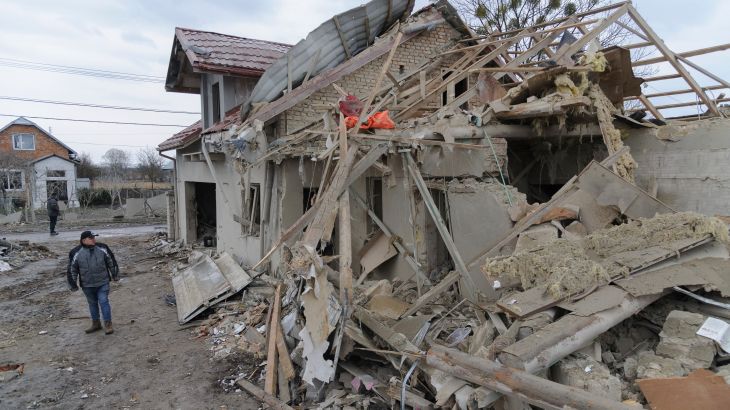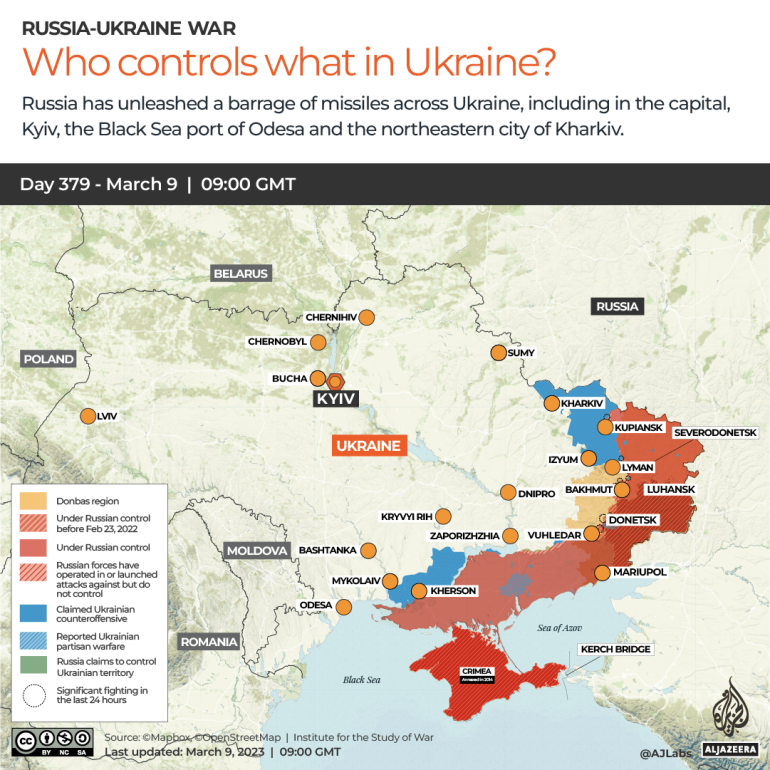Six killed as Russian missile barrage slams into Ukrainian cities
Russia fires dozens of missiles targeting residential buildings and critical infrastructure across Ukraine.

A barrage of more than 80 Russian missiles and a smaller number of exploding drones have hit residential buildings and critical infrastructure across Ukraine, killing six people and leaving hundreds of thousands without heat or electricity.
The largest such attack in three weeks also put Europe’s largest nuclear plant at risk by knocking it off the power grid for hours before it was reconnected. Because nuclear plants need constant power to run cooling systems to avoid a meltdown, the latest threat to the Zaporizhzhia plant again raised the spectre of a nuclear catastrophe.
Keep reading
list of 4 itemsRussia fires barrage of missiles on Ukraine cities
Russia-Ukraine war: List of key events, day 379
‘One day our luck will run out’: UN nuclear chief raises alarm
Air raid sirens wailed through the night as the attacks targeted a wide swath of the country, including western Ukraine, which is far from the front lines. President Volodymyr Zelenskyy said the assault that came while many people slept was an attempt by Moscow “to intimidate Ukrainians again”.
The Russian Defence Ministry said the strikes were in retaliation for a recent incursion into the Bryansk region of western Russia by what Moscow claimed were Ukrainian saboteurs. It claimed to have hit all its intended targets, destroying drone bases, disrupting railways and damaging facilities that make and repair arms.
Ukraine denied the claim of incursion and warned that Moscow could use the allegations to justify stepping up its own assaults.
Nearly half of households in Kyiv were without heat, as were many in Kharkiv, Ukraine’s second-largest city, where the water was also cut on a day when outdoor temperatures were expected to fall to around freezing, local officials said.
Around 150,000 households were left without power in Ukraine’s northwestern Zhytomyr region. In the southern port of Odesa, emergency blackouts occurred due to damaged power lines.
“The occupiers can only terrorise civilians. That’s all they can do. But it won’t help them. They won’t avoid responsibility for everything they have done,” Zelenskyy said, describing strikes that hit infrastructure and residential buildings in 10 regions.

Moscow confirmed it had used hypersonic Kinzhal – Russian for dagger – missiles in Thursday’s attack. Ukrainian officials said it was the first time they had faced so many of the weapons, which Ukraine has no way to shoot down.
Defence and military analyst Pavel Felgenhauer told Al Jazeera from Moscow that the Russian attacks were strategically targeting Ukraine’s power grid system.
“They were called retaliatory attacks, but it’s more or less the same that’s been continuing for some months during this winter by Russia attacking the Ukrainian power grid system, hoping that it’ll break down and the power could soften up Ukrainian leadership and people and that they would agree for a ceasefire that will stop these attacks,” Felgenhauer said.
“These attacks are spectacular. Hypersonic missiles were used, but the strategic objective has not been achieved. The power grid in Ukraine despite all the attacks continues to work more or less and Ukraine does not seem to show a desire right now to agree on Russian terms of a ceasefire.”
Viktor Bukhta, a 57-year-old resident of Kyiv’s Sviatoshynskyi district, where officials said three people were wounded, said a missile landed nearby in the early morning.
“We went into the yard. People were injured,” he said. “Then the cars caught fire. We tried to extinguish them with car fire extinguishers. And I got a little burned.”

Nuclear plant dangers
The head of the United Nations nuclear watchdog said he was “astonished by the complacency” of members of the organisation he leads, the International Atomic Energy Agency (IAEA), in relation to the dangers faced by the Zaporizhzhia plant.
“What are we doing to prevent this happening? We are the IAEA. We are meant to care about nuclear safety,” Director-General Rafael Grossi told the agency’s board of directors in a meeting Thursday, according to a statement from the organisation.
“Each time we are rolling a dice,” he said. “And if we allow this to continue time after time, then one day our luck will run out.”
The agency has placed teams of experts at all four of Ukraine’s nuclear power plants to reduce the risk of accidents. Ukrainian Foreign Minister Dmytro Kuleba tweeted that the attack had “no military objective, just Russian barbarism”.
Smoke could be seen rising from a facility in Kyiv’s Holosiivskyi district, and police cordoned off all roads leading to it.
Three men and two women were killed in the western region of Lviv after a missile struck a residential area, Governor Maksym Kozytskyi said. Three buildings were destroyed by fire, and rescue workers combed through rubble looking for more possible victims, he said.
A sixth person was killed and two others wounded in multiple strikes in the Dnipropetrovsk region that targeted its energy infrastructure and industrial facilities, Governor Serhii Lysak said.
Aside from the hail of missiles, Russian shelling killed six other civilians from Wednesday to Thursday, Ukrainian officials said, including three people at a bus stop in Kherson.